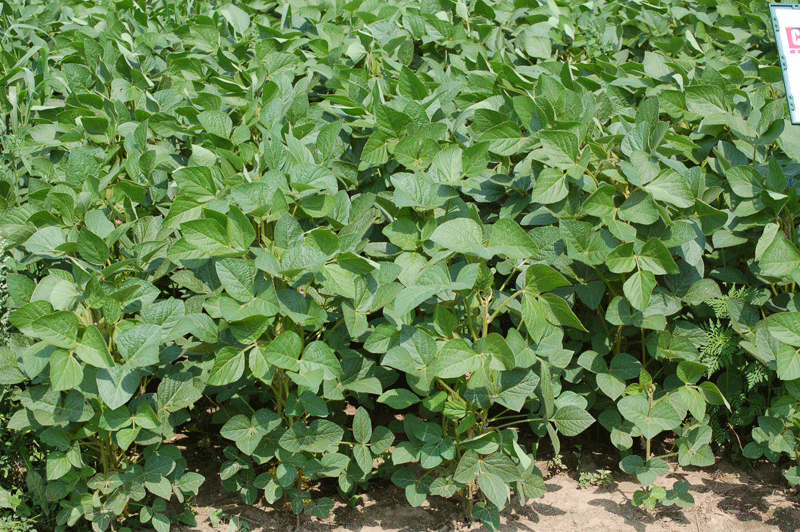SMART soybeans
CORN AND SOYBEAN CROPS AT RISK
USING A COMBINATION of several inputs it is possible to boost soybean yields. The catch is — it’s just not always economically viable to do so.

That was the clear result of SMART II, a collaborative research project conducted by the University of Guelph and the Ontario Ministry of Agriculture, Food and Rural Affairs (OMAFRA). However, a final analysis of the results does show the concept of the “kitchen sink” method has potential. In order to make it work, researchers will need to polish their approach.
Soybean yields have been relatively stagnant over the past two decades, says Horst Bohner, OMAFRA soybean specialist. “Current recommendations in Ontario are based on research with relatively narrow objectives that focus on simple effects of a few factors at a time,” he says. “Crop management needs to consider additive and synergistic effects on yield, seed quality, and profitability.”
That is what the SMART II project did.
THE FIELD SCALE TRIALS
The kitchen sink treatment consisted of the following inputs: Cruiser Maxx seed treatment, Hi Coat inoculant, Quilt foliar fungicide, a higher seeding rate (250,000 seeds/acre), 50 lbs/acre of nitrogen in the form of ESN and ammonium sulphate, three gallons/acre of 2-20-18 liquid applied in the furrow, six litres of slow release nitrogen, and two litres of 3-16-16 foliar fertilizer.
Field scale trials using this treatment were established at 15 sites across the province from 2011 to 2013 in a wide range of CHU zones. Trials were located in the following counties: Kent, Lambton, Middlesex, Haldimand, Norfolk, Perth, Huron, and Wellington.
Field scale treatments included an adapted variety, both untreated and using the kitchen sink treatment, and a +200 CHU variety, untreated and using the kitchen sink treatment.
According to Bohner, an average yield gain of 5.1 bu/ac for adapted varieties and a gain of 4.9 bu/ac for long maturing varieties was realized when the kitchen sink treatment was used. “This approach was not economically profitable on average, though,” he says.
Interestingly, an average yield gain of 2.1 bu/ac was realized when a soybean variety that was 200 CHUs longer than recommended was planted. “This strategy proved to be a viable way to increase soybean yields and profits,” Bohner notes.
In one of the 15 trials, phomopsis seed decay posed a problem in germination. Germination, however, was increased with the kitchen sink treatment. In the presence of significant white mould, seed quality decreased with the use of the kitchen sink treatment for the adapted variety. “This was likely due to the higher seeding rate used in this treatment,” Bohner says.
“Intensive management of soybeans is an effective way to increase yields and in some cases seed quality, especially seed size. However, yield increases did not offset the cost of the inputs used in this study.”
“The next step is to make it more economically viable to apply a package of inputs,” he continues. “One possible way to achieve this goal is to only apply the products in the parts of the field that are the most responsive.”
THE SMALL PLOT TRIALS
The small plot trials, located at Ridgetown and Exeter, differed from the large-scale trials in that they looked at 12 possible combinations in total. Small plots varied in seeding rates (150,000 versus 250,000 seeds per acre), the varieties used, and the use of inputs, including foliar fungicide, nitrogen, and foliar fertilizers. The treatments were evaluated for four adapted and four long-season varieties at each of the two locations.
The results were interesting in that they were unpredictable and varied from one variety to the next, says Dr. Dave Hooker, field crop agronomist and assistant professor at the University of Guelph Ridgetown Campus. “Different varieties responded differently to the inputs,” he says, “but we had no way to predict which varieties would be responders or which varieties were not that much of a responder.”
Although the results were frustrating, Hooker does have a few guesses as to why they differed from variety to variety. For one, longer maturing varieties tend to have more vegetative growth than the regular season varieties, he says. Unfortunately, plant height increased as well, which led to lodging.
“And the amount of lodging increased with the amount of inputs we applied,” he says. “When we set up this experiment, we should have set up a lower population rate, rather than going with a higher population than normal.”
Hooker thinks by adjusting seeding rates back from normal rates the economics could work out. “Usually, when we adjust our management, we’re thinking of spending more on inputs,” he says. “In some cases we know that maybe there’s a better opportunity to cut back on some inputs in some areas in the field. And plant population could be one of those inputs where we could do that.”
Other take-home messages were similar to those of the field-scale trials. Variety maturity plays a big role in yield potential, says Hooker. The later maturing the variety is, the higher the yield.
In the small plots, there was no response to nitrogen whatsoever. “It produced a nice vegetative canopy, but it did not translate into yield,” he says.
Fungicide in a sufficient population does add yield, he continues, but in the longer maturing varieties yield potential can be lower if populations are too high. Finally, the ideal population for soybeans is extremely field and environment specific. “If the environment or the field is such that it can produce a good canopy that fills the rows in by full flowering (R2 stage), that would be the ideal plant population,” says Hooker.
Hooker and Bohner are continuing to look at ways to increase soybean yields. “We’re not quite there yet, but we think that this is a step towards that,” Hooker concludes.
This project was funded in part by Grain Farmers of Ontario. The SMART II project was originally featured in the February 2014 issue of the Ontario Grain Farmer. Find it here. •






















